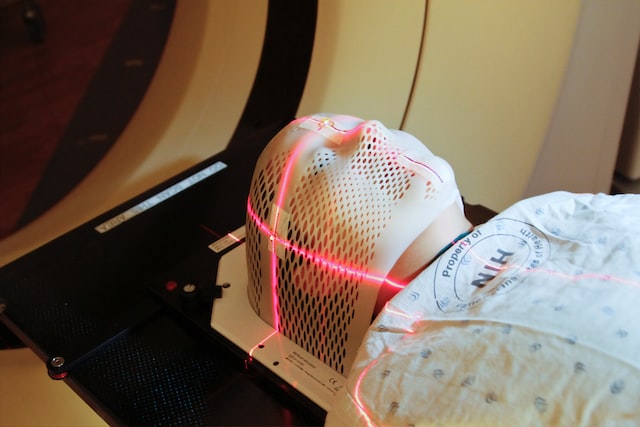CT scans use X-rays to produce images, while MRIs use magnetic fields and radio waves. CT scans are better at imaging bones, while MRIs are better at imaging soft tissues. CT scans can be done on an outpatient basis, while MRIs usually require a stay in the hospital. Finally, CT scans expose patients to more radiation than MRIs.
What is a CT Scan?
(Photo by National Cancer Institute on Unsplash )

A CT (computed tomography) scan, also known as a CAT (computed axial tomography) scan, is a medical imaging procedure that uses X-rays and computer technology to create detailed cross-sectional images of the body.
During a CT scan, the patient lies on a table that moves through a doughnut-shaped machine called a CT scanner. The scanner uses a rotating X-ray beam to take multiple images of the body from different angles. These images are then processed by a computer to create a detailed 3D image of the body part being examined.
CT scans can be used to visualize internal structures of the body such as bones, organs, and tissues. They are commonly used to diagnose and monitor medical conditions such as cancer, heart disease, and neurological disorders. They can also be used to guide biopsies and other medical procedures.
CT scans involve exposure to ionizing radiation, which can be a concern for some patients. However, the benefits of CT scans often outweigh the risks, and modern CT technology has significantly reduced radiation exposure compared to earlier methods. Your doctor will discuss the risks and benefits of a CT scan with you before recommending the procedure.
What is an MRI?
(Photo by National Cancer Institute on Unsplash )

An MRI, or Magnetic Resonance Imaging, is a diagnostic tool used to create detailed images of the body. Unlike a CT scan, which uses X-rays to produce images, an MRI uses a powerful magnetic field and radio waves to create images of the body’s organs and structures.
MRI can be used to detect a variety of conditions, including tumors, spinal cord injuries, and brain abnormalities. It can also be used to guide surgeons during certain procedures. MRI is generally safe for most people, although it is not recommended for pregnant women or people with certain metal implants.
The Difference Between CT Scans and MRIs
There are a few key differences between CT scans and MRIs. Firstly, CT scans use X-rays to produce images, while MRIs use magnetic fields and radio waves. Secondly, CT scans are generally quicker and easier to perform than MRIs. Finally, CT scans can be used to image bones and soft tissues, while MRIs are better for imaging organs and blood vessels.
The reasons to get a CT Scan
There are many reasons why your doctor may recommend a CT scan. CT scans can be used to visualize both hard and soft tissues in the body, which makes them an important tool for diagnosing a wide range of conditions.
CT scans can be particularly helpful in diagnosing cancer, as they can show the size, shape, and location of tumors. They can also be used to identify whether or not cancer has spread to other parts of the body.
CT scans can also be used to diagnose cardiovascular disease, as they can show blockages in the arteries. They can also be used to evaluate the health of bones and joints.
In addition to their diagnostic capabilities, CT scans can also be used for treatment planning. For example, if you are scheduled for surgery, your surgeon may use a CT scan to help plan the best way to approach your particular case.
Overall, CT scans are a valuable tool that your doctor may use for a variety of reasons. If you have any questions about why your doctor has recommended a CT scan, be sure to ask so that you can better understand the purpose of the scan and what it could mean for your health.
The reasons to get a MRI
If you’re experiencing certain symptoms, your doctor may order a computed tomography (CT) scan or magnetic resonance imaging (MRI). These tests help doctors see inside your body to check for problems.
A CT scan uses X-rays and computers to create detailed images of the inside of your body. An MRI uses a powerful magnet and radio waves to create detailed images of the inside of your body.
Your doctor may order a CT scan or MRI to:
- Look for cancer, infection, or other conditions
- Find the cause of unexplained pain
- Check for internal bleeding
- Identify abnormalities in the brain or spinal cord
- Monitor the progression of a disease
- Plan cancer treatment
- Guide procedures such as surgery, biopsy, and radiation therapy
How to Prepare for a CT Scan
There are a few things you can do to prepare for a CT scan. First, you should wear comfortable clothing. You will also need to remove any jewelry or other metal objects. This is because the CT scan uses x-rays, which can be deflected by metal objects. You may also be asked to drink contrast material beforehand. This helps to improve the quality of the images. Finally, you will need to lie still on the table during the procedure.
How to Prepare for a CT MRI
If you are scheduled for a CT MRI, there are a few things you can do to prepare. First, be sure to wear comfortable clothing. You will likely need to remove any metal objects, such as jewelry or piercings. You may also need to remove eyeglasses.You will be asked to lie still on a table during the scan. The table will slide into the MRI machine, which is a large cylinder-shaped machine. You may be given earplugs or headphones to help reduce the noise from the machine. The scan itself is painless, but it can take up to an hour to complete.
The Risks of CT Scans
There are several risks associated with CT scans, including:
- Radiation exposure. A CT scan exposes you to more radiation than a traditional X-ray. The amount of radiation you’re exposed to during a CT scan varies depending on the specific procedure, but it is generally higher than the amount of radiation you would receive during an X-ray.
- Allergic reactions. Some people may have an allergic reaction to the contrast dye used during a CT scan. Symptoms of an allergic reaction may include hives, itching, and difficulty breathing.
- Kidney problems. The contrast dye used during a CT scan can cause kidney damage in some people. This is more likely to occur in people who already have kidney problems or who are dehydrated. Dehydration can also increase your risk for kidney damage from the contrast dye.
- Pregnancy risks. There is a small risk that CT scans may cause harm to a developing baby, so they should be avoided if possible during pregnancy.
The Risks of MRI’s
MRI’s are often thought of as being completely safe, but there are actually some risks associated with them. For one, MRI’s use strong magnetic fields, which can sometimes cause problems for people with pacemakers or other metal implants. Additionally, the loud noise produced by an MRI machine can be detrimental to hearing. Finally, MRI’s can sometimes make people feel claustrophobic due to the small space they are confined to during the scan.
What does a CT scan show that an MRI does not?
While both CT scans and MRIs can provide detailed imaging of the body, there are some key differences between the two tests. CT scans use X-rays to produce images, while MRIs do not use X-rays. This means that CT scans can show bones and soft tissues, while MRIs can provide more detailed images of soft tissues. Additionally, CT scans are typically used to diagnose problems with the head, neck, chest, or abdomen, while MRIs are more often used to assess issues with the brain or spinal cord.
Why would a doctor order an MRI after a CT scan?
There are a few reasons why a doctor may order an MRI after a CT scan. One reason is that MRI can provide more detailed images of soft tissue than CT. Additionally, MRI does not use ionizing radiation, making it a safer imaging modality for certain procedures. Finally, MRI is sometimes used to confirm the findings of a CT scan.
What CT Scan detect?
A CT scan is a low-dose x-ray that produces cross-sectional images of the body. It is used to detect bone fractures, tumors, and other abnormalities. MRI is a imaging test that uses magnetic fields and radio waves to produce detailed images of the body. It is used to detect diseases of the brain and spine, such as multiple sclerosis and cancer.
What MRI’s Detect?
MRI’s are able to detect a number of different things in the body. They can detect abnormalities in the brain, spine, and other organs. They can also be used to diagnose conditions such as cancer, stroke, and heart disease.
Featured Image By – Photo by National Cancer Institute on Unsplash








